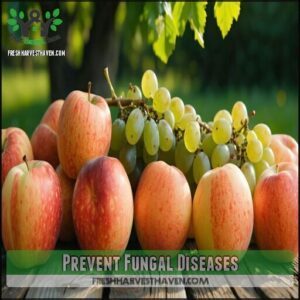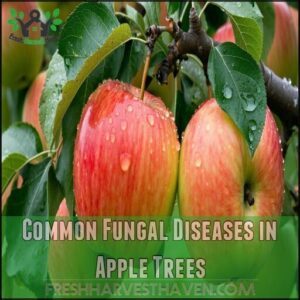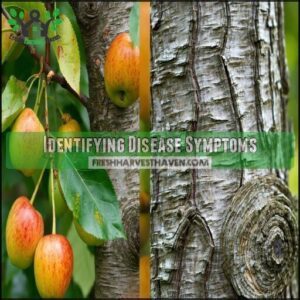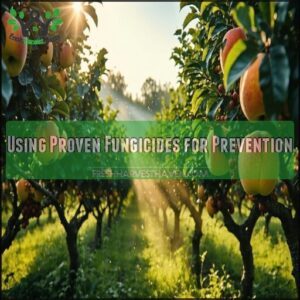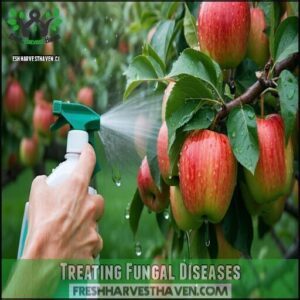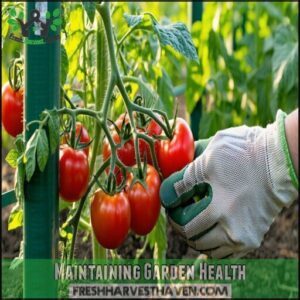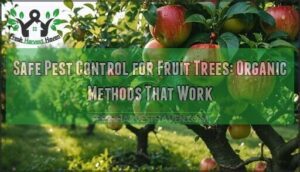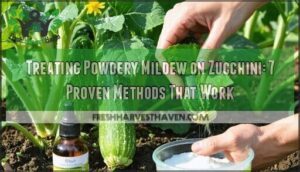This site is supported by our readers. We may earn a commission, at no cost to you, if you purchase through links.
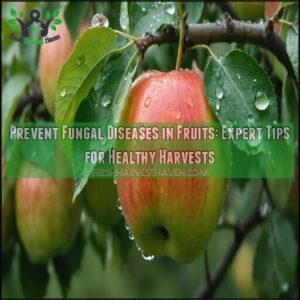 To prevent fungal diseases in fruits, you’ll need to create an environment where pathogens can’t thrive.
To prevent fungal diseases in fruits, you’ll need to create an environment where pathogens can’t thrive.
Space your plants properly to improve air circulation—fungi hate a good breeze!
Water at the base rather than overhead, as wet foliage is like a fungal welcome mat.
Prune regularly to remove infected areas and improve ventilation.
Apply organic fungicides containing copper or sulfur when conditions favor fungal growth (warm, humid weather).
Clean your tools between uses to avoid spreading spores—these microscopic troublemakers are hitchhikers at heart!
Healthy soil with proper drainage creates resilient plants that naturally fight off infections.
Those tiny spores don’t stand a chance against a well-planned defense.
Table Of Contents
- Key Takeaways
- Prevent Fungal Diseases
- Fungal Disease Identification
- Disease Prevention Strategies
- Treating Fungal Diseases
- Maintaining Garden Health
- Frequently Asked Questions (FAQs)
- How do I prevent fungus from damaging my fruit trees?
- Should I treat my fruit trees with fungicide?
- Which fruits are affected by a fungus?
- Do fruit trees have fungal diseases?
- How can I keep my fruit trees healthy?
- How to control plant fungi?
- What fruits are affected by a fungus?
- Do fruit trees need fungicides?
- What causes fungus on fruit?
- Which fruits are anti-fungal?
- Conclusion
Key Takeaways
- You’ll prevent most fungal diseases by improving air circulation – space your plants properly and prune regularly to create an environment where fungi can’t thrive.
- Water at the base of plants rather than overhead to keep foliage dry, as wet leaves create perfect conditions for fungal growth and spore germination.
- Choose disease-resistant varieties from reputable sources and inspect all plants thoroughly before adding them to your garden to establish a strong foundation against infections.
- Maintain clean tools by sanitizing them between uses, apply organic fungicides (like copper or sulfur) preventatively, and remove infected plant material immediately to stop disease spread.
Prevent Fungal Diseases
You can keep your fruit harvest healthy by protecting plants from fungal diseases that thrive in warm, moist conditions.
Focus on selecting resistant varieties, improving air circulation, and watering properly to minimize infection risks.
Selecting Disease-Resistant Fruit Varieties
Start your orchard off right with disease-resistant fruit trees! Choosing the right varieties can save you time, money, and frustration in the fight against fungal diseases.
Look for options suited to your local environment and resistant to common regional fungi.
- Focus on variety selection: opt for proven disease-resistant options like Enterprise apples or Nova raspberries.
Smart gardeners choose disease fighters like Enterprise apples – your first line of defense against fungal invaders!
- Prioritize rootstock resistance: resilient rootstocks boost overall tree health.
- Adapt to local conditions: select varieties suited to your area’s climate.
- Reduce disease pressure: avoid planting overly susceptible breeds.
- Embrace genetic diversity: increase resilience with varied crops.
Fewer fungal worries mean healthier harvests!
Planting Sites for Air Circulation
Where you plant matters for battling fruit fungal diseases.
Smart planting sites do wonders—focus on air circulation and spacing considerations to reduce moisture buildup.
Wide spacing means less humidity, while orienting trees with sunlight exposure strengthens plant health.
Factor in soil drainage and wind direction to create a microclimate that prevents fruit fungus.
Think of it like designing the perfect home for organic fruit protection—a sturdy, breezy layout where fungus hates to hang out.
Healthy plants? They’ll thank you for creating a smart planting site with good air circulation and soil drainage.
Watering Practices for Disease Prevention
To keep your fruits healthy and fend off fungal invaders, rethink how you water. A well-planned approach is key.
- Early Day Watering guarantees leaves dry quickly, leaving spores no chance to thrive.
- Avoid Overhead Watering; instead, choose drip irrigation for focused moisture at the soil level.
- Stick to a consistent watering schedule, avoiding waterlogging by monitoring soil moisture levels.
With proper irrigation techniques, you’ll avoid creating conditions fungi love—like prolonged leaf wetness and high humidity. Combine this with good air circulation for a healthier, more vibrant garden.
Keep those fruits thriving!
Fungal Disease Identification
You need to know what fungal diseases look like so you can act quickly and protect your fruits.
From dark spots on leaves to gnarled growths on branches, recognizing these symptoms is your first step to stopping them.
Common Fungal Diseases in Apple Trees
How do you handle apple fungal diseases that threaten your trees? Apple scab, Cedar Rust, Powdery Mildew, Sooty Blotch, and Flyspeck can wreak havoc if ignored.
Look for olive spots, orange streaks, ghostly powder, or blotchy patches. Quick identification paired with proactive steps like proper pruning and applying fungicides keeps these invaders at bay.
Here’s an at-a-glance guide:
| Disease | Symptom | Conditions | Spread Method | Control Tips |
|---|---|---|---|---|
| Apple Scab | Olive leaf spots | Wet weather | Overwintering spores | Fungicide, leaf cleanup |
| Cedar Rust | Orange leaf spots | Damp spring | Nearby junipers | Remove junipers nearby |
| Powdery Mildew | White leaf coating | Hot, dry periods | Infected shoots | Prune, fungicide |
| Sooty Blotch | Black marks on fruit | High humidity | Aphid honeydew | Sanitation, fungicide |
| Flyspeck | Tiny black dots on fruit | Humid conditions | Spores on debris | Aphid control, sprays |
Spot symptoms early, act swiftly, and keep your fruit thriving!
Fungal Diseases in Other Fruits
Fungal diseases can turn your lush fruit garden into a battleground.
These invisible threats attack various fruits, leaving destruction in their wake. Here’s a quick guide to the top fungal foes:
- Grapes: Powdery mildew dusts vines, stunting growth and spoiling clusters.
- Stone Fruits: Brown rot causes blossom blight and rots fruit from the inside.
- Citrus: Root rot decays bark and compromises tree health.
- Berries: Black lesions and cane blight reduce plant vigor.
- Tropical Fruits: Fruit rot spreads rapidly in humid climates.
Strategic pruning, effective fungicides for fruits, and careful fruit disease management protect your harvest from these menacing fungi. Consider using copper or sulfur for treatment. Stay vigilant! Prevention wins battles.
Identifying Disease Symptoms
Spotting problems early is the best way to outsmart fungal diseases.
Look closely for Leaf Spotting, wilting, or strange Branch Abnormalities like swollen knots or peeling bark. Discoloration Signs on leaves or Fruit Deformities are clear red flags.
Regular inspections help you master fruit disease identification before fungi gain a foothold. White, powdery marks or tiny scars may suggest mildew.
Don’t ignore these subtle tree symptoms—acting fast can save your garden from serious infections. Catching symptoms early transforms potential disaster into healthy harvests.
Disease Prevention Strategies
You can prevent fungal diseases in your fruit plants by starting with disease-free seeds, keeping tools clean, and maintaining proper spacing.
These simple steps lower the risk of infections, protecting your harvest and saving you time and effort later, which is a key part of maintaining healthy plants.
Choosing Disease-Free Plants and Seeds
Choosing the right plants and seeds is like building a strong foundation for your garden.
Start by visiting reputable growers who prioritize quality and plant resistance—this sets you up for success. To guarantee healthy stock, inspect plants thoroughly. Look for vibrant leaves, firm stems, and no signs of discoloration or fungal spots.
Follow these steps:
- Pick disease-resistant varieties: Seek genetic diversity and fruits bred for resistance.
- Conduct seed inspections: Check for damage or mold to guarantee quality.
- Stick with disease-free plants: Trust nurseries offering verified, certified stock.
- Prioritize early detection: Remove questionable plants before they infect others.
This thoughtful variety selection can save you effort, guaranteeing strong, disease-resistant fruit for years. **Consider soil pH and texture for ideal growth.
Keeping Tools Clean and Sterile
Don’t let your gardening tools play double agents in spreading fungal diseases! Proper sterilization methods and cleaning frequency keep your garden safe from cross-contamination.
After pruning trees or working the soil, scrub your gardening tools with soapy water to remove dirt and spores. Follow up with a bleach solution or alcohol wipe to disinfect.
- Keep tools stored dry and sharpen blades often to reduce plant tissue damage.
Consider using a dedicated tool sanitizer for ideal cleanliness. Sanitizing tools like pruning shears and shovels might feel tedious, but it’s worth it when you see a healthy harvest. Think of keeping clean garden tools as giving your plants their best bodyguards.
Using Proven Fungicides for Prevention
Success in fruit disease control starts with selecting the right fungicide for fruits.
Broad-spectrum options like chlorothalonil provide excellent protection, while systemic fungicides work within plants to block potential infections.
Timing and dosage precision are key—apply treatments early in the morning or evening for the best results.
To stay ahead of resistance, rotate fungicide types and mix different chemical groups for a stronger defense.
Safety practices, like following label instructions, guarantee effective and safe fungicide application.
You can find many options for fruit disease control online.
With thoughtful fungicide treatment and application timing, you’ll keep fungal diseases at bay and your harvests plentiful.
Prevention’s your best ally!
Treating Fungal Diseases
To treat fungal diseases effectively, you’ll need to act quickly and choose the right approach for your plants.
Whether you’re using fungicides or trying organic methods, proper timing and careful application are key to protecting your fruit harvest.
Using Fungicides for Treatment
When fungi threaten your fruit trees, fungicides are your secret weapon for fruit disease control.
Here’s a short, engaging blockquote in the same tone as the original paragraph:
Fungicides aren’t just treatments—they’re your fruit trees’ armor in the battle against invisible fungal invaders.
To tackle the problem effectively, you’ll need to know your options, timing, and techniques. Fungicide types, including systemic and protectant varieties, each serve distinct purposes—systemics penetrate plant tissue, while protectants shield from surface infections.
Timing matters too, since fungicide application during humid or wet conditions halts fungal growth before it spreads. Always handle fungicides safely, following all label instructions.
Consider browsing a site for fruit tree treatments to explore available options.
-
Top Tips for Fungicide Treatment:
- Use systemic fungicides for internal protection.
- Apply protectants during high-risk weather conditions.
- Rotate fungicides to prevent resistance.
- Mix sprays properly to maximize treatment effectiveness.
- Stick to manufacturer instructions for application guidance.
Treatment Intervals and Harvest Allowance
Fungicide timing and reapplication needs keep your fruit disease treatment on track.
Stick to crop-specific schedules: apples need 7-10 days between sprays and a 14-day pre-harvest interval, peaches wait 7 days to reapply and 10 before harvest, while cherries vary.
Don’t cut corners—respect these intervals to protect fruits and guarantee safe, healthy harvest timing.
Organic Treatment Options
Balancing nature and science, organic treatments can help you tackle fungal problems effectively.
Neem oil, when mixed with water and dish soap, stops fungal growth while boosting plant health. Got baking soda in your pantry? It’s a reliable, eco-friendly option—just mix it with water for stubborn infections.
For more natural solutions, try garlic spray, made by blending garlic and water, or rely on copper and sulfur fungicides for proven results.
Even beneficial fungi enhance your plants’ defenses naturally!
Using mulch is a form of natural weed suppression.
Maintaining Garden Health
You’ll protect your fruit trees from pathogenic fungi by establishing a consistent maintenance routine that includes proper sanitation and regular monitoring for early symptoms.
A healthy garden ecosystem, with adequate spacing between plants and proper air circulation, creates an environment where fungal spores can’t easily establish themselves, much like how a tidy kitchen deters unwelcome pests.
Regular Maintenance for Disease Prevention
Now that you’ve addressed treatment, let’s talk maintenance—your orchid’s daily shield.
Prune trees annually with sterilized tools to boost air circulation.
Your pruning techniques matter: remove damaged branches at a 45-degree angle for faster healing.
Don’t let fallen leaves become fungal nurseries—practice thorough debris removal.
Nourish soil health with compost, and maintain proper tree spacing.
These prevention strategies aren’t just tasks—they’re your tree hygiene insurance policy against future infections.
Regular sanitation practices, including sterilized tools use, limit disease spread.
Monitoring for Fungal Diseases
Most fungal diseases reveal themselves before widespread damage occurs. Your vigilant monitoring creates the first line of defense against fruit rot and decay.
- Perform weekly visual inspections, examining leaves for discoloration, spots, or powdery residue—common plant disease symptoms
- Track environmental factors like humidity and rainfall that promote fungal growth
- Maintain detailed records of previous infections to establish action thresholds
Early detection is vital! When you spot unusual plant disease symptoms, take a sample to your local extension office for proper identification. Remember, catching problems early saves both time and your precious harvest.
Proactive Measures for Garden Health
While watching for fungal diseases, you’ll also want to establish healthy garden habits.
Your best defense is a good offense, start with proper soil health and plant nutrition to strengthen natural immunity.
Regular garden sanitation by removing fallen leaves and fruits eliminates fungal hideouts.
Early detection through weekly inspections helps you spot plant pathogens before they spread.
Maintain garden hygiene by disinfecting tools between uses.
Consider pest control methods that protect beneficial insects while deterring disease carriers.
Remember: healthy plants resist fungal diseases better, so prioritize plant health through proper watering, spacing, and feeding.
Your garden will thank you, as healthy garden habits are key to a successful harvest.
Frequently Asked Questions (FAQs)
How do I prevent fungus from damaging my fruit trees?
An ounce of prevention is worth a pound of cure.
Choose disease-resistant varieties, prune for airflow, remove infected materials.
Apply fungicides early, water at soil level, and sanitize your tools between trees.
Should I treat my fruit trees with fungicide?
Yes, you should treat your fruit trees with fungicide, especially as a preventive measure.
Regular applications during growing season can protect against common diseases like black rot, scab, and powdery mildew.
Which fruits are affected by a fungus?
Oh, your precious pomegranates aren’t immune!
You’ll find virtually all fruits can fall victim to fungal pathogens, including apples (scab), peaches (leaf curl), berries (gray mold), citrus (anthracnose), and stone fruits (brown rot).
Do fruit trees have fungal diseases?
Fruit trees commonly battle numerous fungal diseases like black rot, apple scab, and powdery mildew.
You’ll notice symptoms including discolored leaves, deformed fruit, and abnormal growths if your trees are infected.
How can I keep my fruit trees healthy?
Like vigilant sentinels, healthy fruit trees require proper spacing, regular pruning, resistant varieties, and timely fungicide application.
You’ll need to water at soil level and remove infected debris to prevent disease spread, utilizing resistant varieties.
How to control plant fungi?
Control plant fungi by improving air circulation, watering at the base, removing infected parts, and applying appropriate fungicides. You’ll need to act quickly when symptoms appear to prevent disease spread.
What fruits are affected by a fungus?
Apples, pears, peaches and cherries all face fungal foes. You’ll find that most fruits are susceptible to various fungal diseases like black rot, powdery mildew, scab and leaf spot.
Do fruit trees need fungicides?
Many fruit trees do need fungicides to protect against diseases like black rot, scab, and leaf spot.
You’ll get healthier harvests by applying preventative treatments, especially during wet conditions when fungi thrive.
What causes fungus on fruit?
Just as dampness invites unwelcome guests, your fruit trees attract fungal spores during humid conditions.
You’ll find these pathogens thriving when moisture lingers on leaves and fruits, especially in warm temperatures with poor air circulation.
Which fruits are anti-fungal?
Your kitchen’s natural fungal fighters include goji berries, papaya, citrus fruits (orange, lemon, grapefruit), banana peels, and various berries.
You’ll benefit from their bioactive compounds that naturally inhibit fungal growth in both culinary and medicinal applications.
Conclusion
Fighting fungal diseases in your fruit garden is like building a fortress against an invisible army.
By implementing proper spacing, strategic watering, and timely pruning, you’ll create an environment where pathogens can’t establish.
Remember to maintain clean tools, apply appropriate fungicides when needed, and prioritize soil health.
Your vigilance and these preventative practices to prevent fungal diseases in fruits will reward you with a bountiful, healthy harvest that’s worth every careful step you’ve taken.

